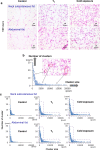In vivo emergence of beige-like fat in chickens as physiological adaptation to cold environments
- PMID: 33598768
- PMCID: PMC7979618
- DOI: 10.1007/s00726-021-02953-5
In vivo emergence of beige-like fat in chickens as physiological adaptation to cold environments
Abstract
While it has been hypothesized that brown adipocytes responsible for mammalian thermogenesis are absent in birds, the existence of beige fat has yet to be studied directly. The present study tests the hypothesis that beige fat emerges in birds as a mechanism of physiological adaptation to cold environments. Subcutaneous neck adipose tissue from cold-acclimated or triiodothyronine (T3)-treated chickens exhibited increases in the expression of avian uncoupling protein (avUCP, an ortholog of mammalian UCP2 and UCP3) gene and some known mammalian beige adipocyte-specific markers. Morphological characteristics of white adipose tissues of treated chickens showed increased numbers of both small and larger clusters of multilocular fat cells within the tissues. Increases in protein levels of avUCP and mitochondrial marker protein, voltage-dependent anion channel, and immunohistochemical analysis for subcutaneous neck fat revealed the presence of potentially thermogenic mitochondria-rich cells. This is the first evidence that the capacity for thermogenesis may be acquired by differentiating adipose tissue into beige-like fat for maintaining temperature homeostasis in the subcutaneous fat 'neck warmer' in chickens exposed to a cold environment.
Keywords: Avian models; Beige fat; Cold adaptation; Thermogenesis; avUCP.
Conflict of interest statement
The authors declare that they have no conflict of interest.
Figures



Similar articles
-
Overexpression of Adiponectin Receptor 1 Inhibits Brown and Beige Adipose Tissue Activity in Mice.Int J Mol Sci. 2021 Jan 18;22(2):906. doi: 10.3390/ijms22020906. Int J Mol Sci. 2021. PMID: 33477525 Free PMC article.
-
Cold adaptation in pigs depends on UCP3 in beige adipocytes.J Mol Cell Biol. 2017 Oct 1;9(5):364-375. doi: 10.1093/jmcb/mjx018. J Mol Cell Biol. 2017. PMID: 28486585
-
Cold acclimation enhances UCP1 content, lipolysis, and triacylglycerol resynthesis, but not mitochondrial uncoupling and fat oxidation, in rat white adipocytes.Am J Physiol Cell Physiol. 2019 Mar 1;316(3):C365-C376. doi: 10.1152/ajpcell.00122.2018. Epub 2019 Jan 9. Am J Physiol Cell Physiol. 2019. PMID: 30624981 Free PMC article.
-
Maintaining mitochondria in beige adipose tissue.Adipocyte. 2019 Dec;8(1):77-82. doi: 10.1080/21623945.2019.1574194. Epub 2019 Feb 20. Adipocyte. 2019. PMID: 30686106 Free PMC article. Review.
-
UCP1 Dependent and Independent Thermogenesis in Brown and Beige Adipocytes.Front Endocrinol (Lausanne). 2020 Jul 28;11:498. doi: 10.3389/fendo.2020.00498. eCollection 2020. Front Endocrinol (Lausanne). 2020. PMID: 32849287 Free PMC article. Review.
Cited by
-
Fighting Fat With Fat: n-3 Polyunsaturated Fatty Acids and Adipose Deposition in Broiler Chickens.Front Physiol. 2021 Sep 29;12:755317. doi: 10.3389/fphys.2021.755317. eCollection 2021. Front Physiol. 2021. PMID: 34658934 Free PMC article. Review.
-
Honeybee-Gilliamella synergy in carbohydrate metabolism enhances host thermogenesis in cold acclimation.NPJ Biofilms Microbiomes. 2025 Aug 25;11(1):172. doi: 10.1038/s41522-025-00798-4. NPJ Biofilms Microbiomes. 2025. PMID: 40850953 Free PMC article.
-
Tetrabromobisphenol A and Diclazuril Evoke Tissue-Specific Changes of Thyroid Hormone Signaling in Male Thyroid Hormone Action Indicator Mice.Int J Mol Sci. 2022 Nov 26;23(23):14782. doi: 10.3390/ijms232314782. Int J Mol Sci. 2022. PMID: 36499108 Free PMC article.
-
Function of Chick Subcutaneous Adipose Tissue During the Embryonic and Posthatch Period.Front Physiol. 2021 Jun 22;12:684426. doi: 10.3389/fphys.2021.684426. eCollection 2021. Front Physiol. 2021. PMID: 34239450 Free PMC article.
-
m6A-Mediated PPARA Translational Suppression Contributes to Corticosterone-Induced Visceral Fat Deposition in Chickens.Int J Mol Sci. 2022 Dec 12;23(24):15761. doi: 10.3390/ijms232415761. Int J Mol Sci. 2022. PMID: 36555401 Free PMC article.
References
-
- Azad KMA, Kikusato M, Hoque AM, Toyomizu M. Effect of chronic heat stress on performance and oxidative damage in different strains of chickens. J Poultry Sci. 2010;47(4):333–337. doi: 10.2141/jpsa.010025. - DOI
-
- Barbatelli G, Murano I, Madsen L, Hao Q, Jimenez M, Kristiansen K, Giacobino JP, De Matteis R, Cinti S. The emergence of cold-induced brown adipocytes in mouse white fat depots is determined predominantly by white to brown adipocyte transdifferentiation. Am J Physiol Endocrinol Metabol. 2010;298(6):E1244–1253. doi: 10.1152/ajpendo.00600.2009. - DOI - PubMed
MeSH terms
Substances
Grants and funding
LinkOut - more resources
Full Text Sources
Other Literature Sources

